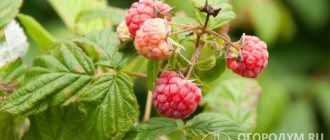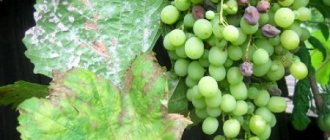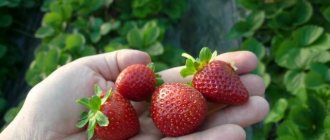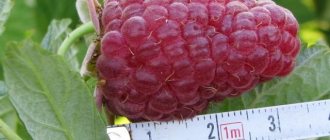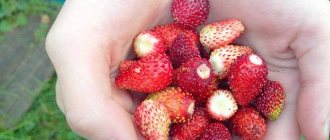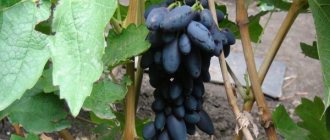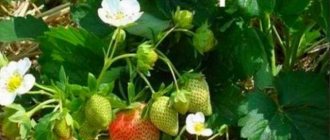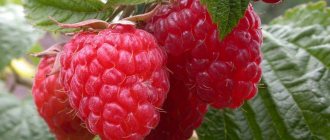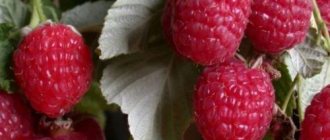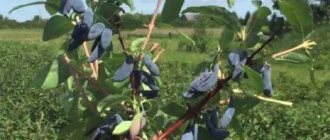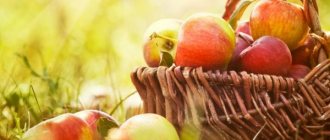A relatively new variety of remontant raspberry, Joan J, is famous for its large fruit, excellent taste and abundant yields. However, the berries quickly overripe and do not tolerate transportation and long-term storage, so the variety is more suitable for growing in small quantities in private garden plots, for fresh consumption and frequent collection.
Characteristics of the Joan G variety
Typically, remontant varieties have a certain taste. The same cannot be said about Joan Jay's raspberries. Jenning Derek produced plants that deserved 4.7 out of 5 possible tasting points.
- Joan Jay raspberries with early and long ripening. The fruits appear in July and continue to please until mid-October.
- Plants with small, up to 1 m bushes. With thick, elastic shoots. There are no thorns.
- Each stem produces more than 5 shoots with a length of up to 50 cm. And on each in the first year, from 60 to 80 large berries appear, weighing from 6 to 8 g. Rich red in color, with a sweet-sour, dessert taste and raspberry aroma.
- Unripe fruits have white tips, while ripe ones have uniform coloring.
- The culture withstands drought and high temperatures.
- Plants can withstand frosts without shelter down to -16 degrees.
- Although the plants are unpretentious, they love feeding.
- And garters on the trellises so that the branches do not bend or break.
- Joan G raspberries are processed and frozen.
- It is not grown on farm plantations because it does not behave well during transportation and does not withstand long-term storage. It is usually grown by gardeners and small farms.
Description of the raspberry variety John Jay
The new variety Joan J (John Jay) was bred at the UK Plant Science Research Institute in 2008. The work of the breeders was carried out within the framework of the specialized Medway Fruits program. Scotsman Derek Janing worked on the creation of a new hybrid.
In this case, the parent pair of raspberry varieties Terri-Louise and Joan Squire was used.
As a result of crossing, it was possible to obtain a remontant variety. This term refers to those raspberry varieties whose berries are formed on the shoots of the current year. In all other cases, shoots grow in the first year, and only in the second year do berries ripen on these branches.
According to the description of the variety, John Jay raspberry bushes are characterized by small sizes - their average height is 100-120 cm. Each of the thick, strong branches contains 5-10 young shoots. They produce heavy, juicy berries.
Another important characteristic of this variety is the absence of thorns along the entire length of the branches. This makes caring for plants and harvesting easier.
The leaves are characterized as slightly wrinkled, bright green in color. Each leaf consists of 3-5 fragments with jagged edges.
Wide-conical, relatively large berries are formed on fruiting shoots. When technically ripe, the fruits acquire a bright red hue with a pronounced shine. Full ripeness can be judged by the appearance of a dark red hue (close to cherry). A distinctive characteristic of the berries of this variety is their tips, which are distinguished by a less intense color.
John Jay raspberries do not fall off after ripening; the berry is easily removed from the stalk and falls apart. The fruit pulp is dry, but the skin is thin and tender. Joan J has a sweet and sour taste and a pronounced raspberry aroma. The berry is well suited for fresh consumption; it can be frozen and used to make compotes, jams, and pie fillings.
We recommend that you read: Sheltering remontant raspberries for the winter
Breeders recommend harvesting when they reach technical ripeness (when the berries become brightly colored). In this case, the fruits are stored longer and can be transported over long distances.
Strengths and weaknesses of the Joan G variety
The comments about Joan Jay are good.
The advantages include:
- Easy removal of ripe fruits from the stalks, so there is no shedding.
- Thanks to the thick skin, the berries can be preserved during transportation and harvesting.
- Fruits with good taste.
- Resistant to drought and heat.
- The plants have many shoots, so it reproduces easily.
Disadvantages relate to:
- Not very good winter hardiness. Plants are covered for the winter. Or they are grown only in the south without shelter.
- Without abundant feeding, Joan Jay's raspberries will not survive; the berries will begin to shrink and become tasteless.
Important!
Although all remontant crops have these disadvantages. If you care for it properly, you can collect up to 6 kg from each bush. Or 18 tons from 1 hectare.
Reviews from gardeners
Raspberries called “Joan G” are characterized positively; in reviews from gardeners, this variety is noted as highly marketable, productive and well suited for growing in home gardens.
When cultivating, you should pay attention to the fact that the berries are prone to over-ripening quite quickly, which requires daily harvesting. The keeping quality and transportability of the harvested crop, according to gardeners who cultivate this variety, are at the highest level.
How to land correctly
Important!
Purchase seedlings from nurseries that have good recommendations in reviews.
- Throughout the growing season, you can plant Joan Jay raspberries. Typically, shoots with closed root systems are planted when it is mid-spring and before frost. 99% of the time they take root. But this figure applies to the south.
- For survival, dip the roots in biostimulants or in a solution with phosphorus-potassium fertilizers.
- Raspberry fields should be sunny with protection from wind and draft. The soil is loose, nutritious, drained.
- 30 days before planting, prepare the holes by enriching the soil with organic matter from humus or rotted manure. You can use the pit or trench method.
- When planting, pour about 30 liters of water under each plant.
- Next season you will already have berries. And if planting was done in the spring, then this year.
Does first mean best?
Not so long ago, remontant varieties of raspberries became a real discovery for our gardeners, allowing them to see, and not only see - and eat plenty of berries, and even prepare them for future use already in the year of planting. Repairers are significantly easier to care for and have no problems with wintering, pests, diseases that have accumulated over the season - cut them out after fruiting in the fall to “zero”, and that’s it, new powerful stems will come out of the ground in the spring. But I still wanted something more from them. Eh, if only there were no thorns yet... the summer residents sighed sadly, remembering their scratched hands in the battle for the harvest of delicious berries. And they smiled sadly, realizing that these were just crimson fantasies...
And now, completely unexpected and revolutionary news that immediately awakened the desire to own this “miracle” was the appearance of the first thornless repairman - Joan J. This “British” entered our market about 5-6 years ago, and many people who grow it still have it as their favorite.
Let's take a closer look at the history of its creation and characteristics in order to better understand why it is so popular, except for the lack of thorns.
Rules of care
- Choose the right, well-lit place for the raspberry plant. Thin out the bushes. Remove old, excess growth.
- On summer, especially dry days, watering 25 liters per meter is mandatory. You can pour water into the grooves made with a hoe. You can arrange rain watering in the morning and evening.
- The soil should be loosened, free of weeds, with mulch made from organic raw materials.
- Fertilize often and a lot. As soon as the snow melts, give the first portions to Joan Jay. Scatter organic matter and minerals over the soil. Feed the raspberries a second time when they are actively growing with liquid fertilizer containing mullein or chicken manure with water.
- Raspberry Joan Jay loves mineral fertilizers made from urea and ammonium nitrate. When the second half of summer arrives, irrigate the raspberries with mineral fertilizer.
- Give the crop preventive maintenance 4 times a season to prevent infections and pests from appearing.
- It is better to tie up bushes with berries. You can use supports or wire. Otherwise, a bountiful harvest will tilt them toward the ground.
- Carry out pruning in spring and autumn. The main pruning is when there are no more berries on the bushes. Cut out all one-year growth, leaving 3 cm. In the spring, in mid-April, carry out sanitary pruning. Remove diseased and dried out plants. Leave the shoots up to the length of 1 healthy bud.
- By winter, cover the plants with pine spruce branches, sawdust, and straw. When snow appears, make mounds out of it.
Important
! Snow cover with mounds above the raspberries is the best.
- For propagation, dig up root shoots and plant them as you would seedlings. Joan Jay can reproduce herself well and quickly.
- Regular harvesting is necessary, preferably every week, so that the berries do not become overripe.
Recommendations for cultivation
When caring for Joan G raspberries, you should remember that the plant loves light, and if the plantings are too dense, the yield decreases sharply. In addition, when providing care, you should adhere to the following recommendations:
- Irrigation is most necessary for raspberries in the summer months, when irrigation activities are organized at the rate of 2-3 buckets for each linear meter of berry crop planting;
- the most effective way to irrigate raspberry bushes is to water along pre-arranged furrows, and moisture-recharging irrigation can be done both along furrows and by sprinkling;
- plants can be fed with diluted and dry ash, as well as mullein diluted in a ratio of 1:10;
- In early spring, it is recommended to feed raspberries with saltpeter or urea at the rate of 60-70 g per square meter.
Preventive measures, including treatment against plant parasites and diseases, should be carried out competently and in a timely manner. As a rule, four sprays are used for the entire season. Pruning should be done in late autumn; in addition, it is recommended to cover the bushes for the winter.
You may also be interested in the article in which we talk about the Brusvyana variety of raspberries.
a brief description of
Advantages of the variety
Domestic gardeners are very pleased with the Joan Jay variety. It is distinguished by:
- large fruit, excellent taste;
- duration of fruiting;
- high yield rates;
- thornless, which makes it easier to pick berries and care for raspberries;
- the fruits are easily separated from the stalk;
- resistance to diseases and most pests;
- ability to do without watering during periods of drought;
- ease of reproduction.
Disadvantages of the variety
- poor frost resistance – can withstand frosts down to -16 ° C;
- obligatory garter;
- strong dependence of yield on soil fertility;
- a large number of shoots;
- late ripening, under unfavorable conditions the crop simply does not have time to ripen completely;
- rapid ripening, daily harvesting is recommended.
The variety grows well in the southern regions of Russia, and in harsher climates it requires careful care and attention.
You might be interested! Description of one of the largest-fruited varieties (berries up to 10-12 g) among the remontant varieties - Atlant raspberry.
Description
Bushes of medium vigor, height from 1 to 1.5 meters. The stems are thick, powerful, and well branched. The length of the sides is 50-70 cm, and the main thing is that on each of them full-fledged fruit branches are formed - laterals, as on productive varieties of summer raspberries. A big plus is that the shoots are absolutely smooth - without any thorns, light green in color, erect, but due to the high yield they can bend to the ground, loaded with fruits. Therefore, it is very desirable to use a trellis to obtain a full harvest and placing branches on it greatly facilitates caring for plants and selecting berries. The leaves are large, with three or five leaflets and a deep pattern.
One of the undeniable and main advantages is its excellent taste, one of the best among all remontants. The berry is sweet, juicy, with a rich raspberry aroma. The sweetness persists even in cool rainy weather. The berries are large, wide, elongated-conical in shape, very smooth, bright red, most likely even ruby, but darken when fully ripe.
They are easily separated from the fruit stem, with a dry separation. The drupes are uniform, small, well interconnected. Berries weighing 4-6 grams, can reach up to 8 grams. The average weight in the season is 5 g and throughout its entire duration the fruits do not become significantly smaller. The pulp is quite dense and elastic, but the skin itself is of medium strength. When ripe, they can hang on the bush without shedding for up to a week, but in the hot summer months the dark berries burn heavily in the sun, and this is considered one of the problems in cultivating Joan Jay, especially for the southern regions. The solution is to grow in tunnels covered with agrofibre, opaque film, or a shading net over the plantation. But this is not convenient and accessible for everyone.
The berries ripen from the base to the tip, which demonstrates the degree of their ripeness and serves as a kind of indicator of readiness. For transportation and subsequent sale, it is advisable to take fruits with a light tip, but for personal consumption, canning, freezing, take fully colored ones, in which all the wonderful aroma and rich taste are widely revealed. So the English originator of the variety for commercial purposes recommends a daily selection of fruits with an incompletely colored tip.
